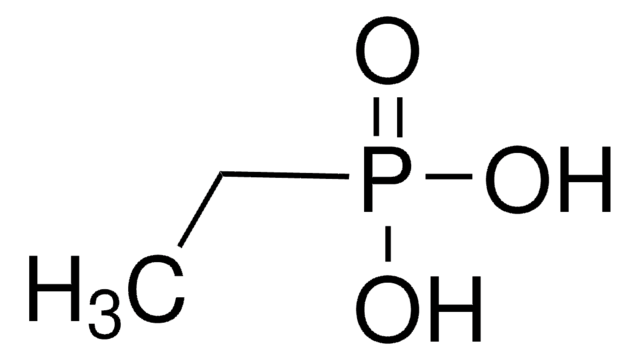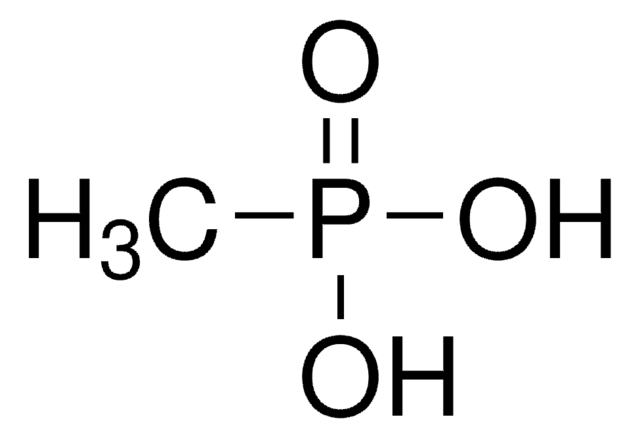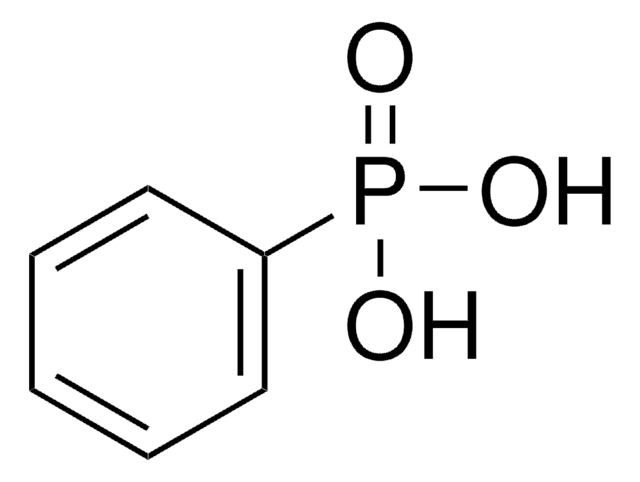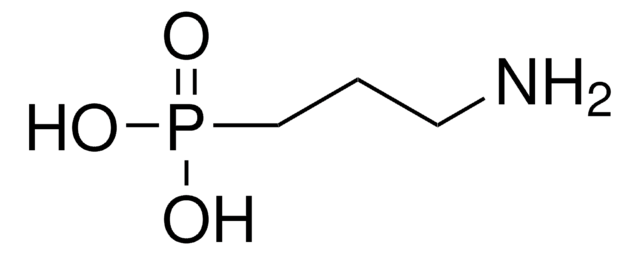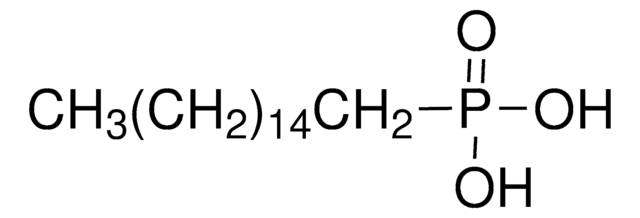305685
Propylphosphonic acid
95%
Sinonimo/i:
Dihydrogen propylphosphonate, P-Propylphosphonic acid, Propanephosphonic acid, Propylphosphonic acid anhydride, n-Propylphosphonic acid
Autenticatiper visualizzare i prezzi riservati alla tua organizzazione & contrattuali
About This Item
Formula condensata:
CH3CH2CH2P(O)(OH)2
Numero CAS:
Peso molecolare:
124.08
Numero CE:
Numero MDL:
Codice UNSPSC:
12352100
ID PubChem:
NACRES:
NA.22
Prodotti consigliati
Categorie correlate
Descrizione generale
Propylphosphonic acid is an alkylphosphonic acid. It is an important marker of extremely toxic nerve agents.
Applicazioni
Propylphosphonic acid was used in generation of free radicals, to investigate the inactivation of Aeromonas hydrophila by free radicals, generated spontaneously in oxidizing Fe2+-containing groundwaters.1
Avvertenze
Danger
Indicazioni di pericolo
Classi di pericolo
Skin Corr. 1B
Codice della classe di stoccaggio
8A - Combustible corrosive hazardous materials
Classe di pericolosità dell'acqua (WGK)
WGK 1
Punto d’infiammabilità (°F)
Not applicable
Punto d’infiammabilità (°C)
Not applicable
Dispositivi di protezione individuale
Eyeshields, Faceshields, Gloves, type P3 (EN 143) respirator cartridges
Scegli una delle versioni più recenti:
Possiedi già questo prodotto?
I documenti relativi ai prodotti acquistati recentemente sono disponibili nell’Archivio dei documenti.
I clienti hanno visto anche
Inactivation of Aeromonas hydrophila by Fe(II)-related-radical generation in oxidizing groundwaters.
I Kersters et al.
Applied and environmental microbiology, 62(9), 3277-3283 (1996-09-01)
The survival of Aeromonas hydrophila AWWX1 in filter-sterilized phreatic groundwaters was studied by using viable counts. Aeromonas counts rapidly decreased 2 to 3 log units in oxidizing raw groundwaters from Snellegem and Beernem, Belgium (Snellegem-raw and Beernem-raw, respectively), containing high
Jens Martens-Lobenhoffer et al.
Journal of chromatography. B, Analytical technologies in the biomedical and life sciences, 990, 164-168 (2015-04-16)
Fosfomycin is a small, hydrophilic antibiotic drug with activity against Gram-positive as well as Gram-negative pathogens. It is in increasing use in intensive care units as a last line antibiotic since it shares no cross-resistance with other antibiotics. It is
Deepak Pardasani et al.
Journal of chromatography. A, 1141(2), 151-157 (2006-12-19)
Alkylphosphonic acids (APAs), particularly the methyl-, ethyl-, isopropyl- and n-propyl-phosphonic acids are important markers of extremely toxic nerve agents. Hence, their detection and identification is of vital importance to verification of chemical weapons convention (CWC). Verification analysis of CWC requires
Arnaud Demortière et al.
The journal of physical chemistry letters, 9(8), 1900-1906 (2018-03-29)
Colloidal semiconductor nanocrystals are commonly grown with a shell of a second semiconductor material to obtain desired physical properties, such as increased photoluminescence quantum yield. However, the growth of a lattice-mismatched shell results in strain within the nanocrystal, and this
Gulzar A Rather et al.
BMC plant biology, 19(1), 301-301 (2019-07-12)
Nothapodytes nimmoniana, a plant of pivotal medicinal significance is a source of potent anticancer monoterpene indole alkaloid (MIA) camptothecin (CPT). This compound owes its potency due to topoisomerase-I inhibitory activity. However, biosynthetic and regulatory aspects of CPT biosynthesis so far
Global Trade Item Number
| SKU | GTIN |
|---|---|
| 305685-1G | 4061826668337 |
| 305685-250MG |
Il team dei nostri ricercatori vanta grande esperienza in tutte le aree della ricerca quali Life Science, scienza dei materiali, sintesi chimica, cromatografia, discipline analitiche, ecc..
Contatta l'Assistenza Tecnica.

